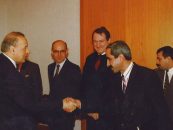The armour and weaponry were often symbols of status, wealth and power. The finest arms were made by master craftsmen working with leading silversmiths as well as with jewellers, whose work transformed utilitarian military equipment into courtly works of art. Islamic arms and specifically of the Caucasian and South Azerbaijani (presently in NW Iran) have only recently emerged as a subject of serious study by specialists, for which there still little published information. This publication attempts to address that need and to reveal the diversity and artistic quality of one of the most important craftsmanship in Azerbaijani history and reveal old skills by the modern artists.
The west has been fascinated with oriental arms since the middle ages. Islamic arms were also appreciated by their owners on other levels: for their construction and use of technologies, unknown in the West, such as edged weapons with blades of “watered” crucible steel, gun barrels of highly figured “Damascus twist” forging and flexible bows of composite construction, which were invented and used by the Turkic tribes worldwide and later on adopted by the nations who remained under the rule of the Turkic tribes.
The first bloom of the weapon making within Azerbaijani society started in period related to the spread of Turkic tribes from Altai region, gradually evolving into famous Safavid period in Persia. It was a time, when Shakh Ismayil I came into power and Azerbaijani Turks accumulated all military and political power, expanding original boundaries for 16 other regions. One of the most beautiful swords in human history were made by the swordsmiths who were at the court of Shah Ismayil and Shah Abbas. It is worth specifically to mention great Azerbaijani Turkish craftsman called Asad Allah Isfahani, who was brought to work at the court for Safavids in Isfahan. There is many swords and daggers made by this talented person in different museums worldwide, and there were also many copies of his works made later on and during his life time by others. He became part of great history, to say the least.
Many state of the art arms were made during the times of Qajar Turkish Dynasty in Iran. And not only arms, in fact I came across hundreds of beautiful copper and brass items.
It was common to make inscriptions on shamshir swords and daggers, specifically using certain Sura’s of the Quran. Quite common was to use a so called “ Al Fatiha” (Victory) Sura. The other writings that were found common were as follows: O you who are gentle and who are infinite, Be gentle to us in all that comes to us, You are the Powerful, so save us From your wrath on the day of disturbance (Day of Judgement).
Many great smiths were alive, but after the division of Azerbaijan between Russian Empire and Persia in 1828, nation unfortunately lost major crafts. These days there is only a few people who understand the secrets of that ancient profession and try to revive it for the next generations. Unfortunately present system not only does not support but also extinguishes a starting flame of blacksmithing and swordmaking in Azerbaijan. Which is very pity, as we lose another craftsmanship once known by our forefathers, which can potentially bring money into our economy and revive folk art, make Azerbaijan known not only for oil and gas but for other domains.
Our story this time will be devoted to a person, who started to study Caucasian arms and armour since he was 11 years old and converted his interest into major hobby of his life besides his Coastal Engineering and Geosciences Degree from Germany. He is a PhD, who speaks fluently 7 languages. Spent extensive time abroad, practicing different fields of engineering and traditional edged weapon making, knows other cultures and presently lives in Canada.
Forged largely from sheets of iron, beaten with hammer and stake into elaborate sculptures of defence, the warrior’s armour served him in several important ways. This connection between our modern sensibilities and the long passed romance of the past has been founded on a powerful literary tradition, strengthened by the existence and magic provided by surviving arms and armour. Through his art, Emin has succeeded in communicating across the ages, mooring the traditional values and ideals to the iron sheet that is his medium and through that sheet to us.
It is in the practice of his craft, through the use of hammer, forge and stake, that the armourer can do more than merely mold steel to his will. If he succeeds in capturing this elusive but very important “spark”, combining the armourer’s function with the essence of character that transmits a message through the ages, then he has created art, much as a fine painting or sculpture preserves the soul of the subject.
Initial steps were quite difficult to take as there were not enough sources to refer to. Emin spent long time in museums, reading books. He tried to find people who had kept at least some secrets of hands on experience of various trades from wood carving, blacksmiths till jewelry makers with various successes.
This trade requires significant financial investments as it involves silver, gold and other semi- precious materials. But revival of this craftsmanship is directly related to spiritual health of our people. The more young people would find interest in traditional weaponry making, the healthier the nation in general will become.
Unfortunately there is no specialists of Caucasian weaponry in the Museum of History of Azerbaijan. Subject is completely avoided discussion and research by the ministry of culture for some unknown reason. Present legislation does not support traditional craftsmanship and sword making, on the contrary it destroys the last chance for it’s revival in Azerbaijan. Old known masters are placed in dire conditions and circumstances to pass their art and knowledge to the next generation. Unless government will arrange state supported workshops in traditional cultural centres country wide or at least will not hamper those handful of craftsmen who still have stamina to create what they do, the whole specialization will be gone into history.
Emin acquired his initial knowledge from the well- known Baku artist Mr. Alexander Volovik and continued education with A. Danelia. Lots of information on various subjects was taken from diverse literature sources.
Emin works primarily with traditional edged weapons. His favourite topic is hand production of Azerbaijani Shamshirs (swords), Caucasian daggers (khanjars) and shashkas. He uses different patterns as traditional Azerbaijani, as well as the Circassian and Dagestani ornaments if ordered by his clients.
Mr. Mammadov is a member of the Canadian Guild of Armourers, took recently second place in Canadian competition of armour makers in 2016. His works are in 2 major museums in Israel and Azerbaijan as well as in many private collections. The Circassian Museum in Kfar Kama (Israel) issued a separate certificate of recognition to Emin for his work.
Emin has made recently a shashka sword, which he devoted to the memory of all demised Azerbaijani warriors who gave their lives for the sake of cleaning of Azerbaijani lands from Armenian occupants. Project took approximately 2 months, involved work on OU31 steel, niello technique on silver, hand engraving, oxidation and other processes. Project was also decorated by the idea of implementing a 19th century picture of Azerbaijani nobleman from Shusha of Karabakh region, made by famous Russian traveller and painter artist V.V. Vereshagin in the early 19th century. This idea came all of a sudden during a dispute with one of his acquaintances from Baku, who supports traditional arts and crafts and was pondered overnight and finally accepted. The project can be seen on Youtube under the name (Памятник Азербайджанским Воинам).
.
Emin Mammadov is not pessimistic at all, he sees lots of future in Elmar Jaffarov and Saftar Ahmedov, both very talented smiths. Both of them will write their own pages in history of Azerbaijani Traditional Blade Craftsmanship Art. He stays in close contact with his colleagues from North Caucasus, Georgia, Israel, Turkey, Iran, Ukraine and Russia.
He carefully speaks to every customer, trying to understand all aspects of future project. Not every customer will be approved as future client, many things depend upon energy which is held within that person, how much care will be given to the sword in future. It is a shared responsibility between a swordmaker and sword owner, which is understandable knowing length of work and number of efforts it takes to complete a single project.
Emin takes pride in his creations.
We, in our turn enjoy responsibly his traditional craftsmanship and look forward to talk to this talented artist and interesting person again.






